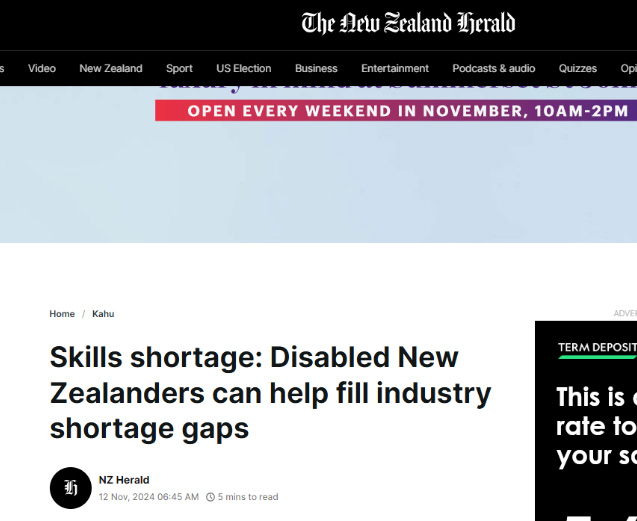New Study to Boost Industry Employment of Disabled Kiwis
This content was written by Impact PR on behalf of Workforce Development Councils Hanga-Aro-Rau and Waihanga Ara Rau. The Auckland public relations agency’s campaign was covered by multiple news titles, including NZ Herald, Newstalk ZB, RNZ and more.
Thousands of disabled workers could help fill a growing skills shortage in New Zealand industries, following the release of new research.
Commissioned by Hanga-Aro-Rau and Waihanga Ara Rau, the Workforce Development Councils for manufacturing, engineering, logistics (MEL), construction, and infrastructure, the report was developed by researchers with lived experience of disability. The release comes as Stats NZ data highlights that workforce participation for disabled adults has dropped from 45% to 44.7% over the past decade, while non-disabled participation has risen from 72% to 84.1%.

The study underscores a significant untapped labour pool, with an estimated 268,900 disabled adults representing a potential workforce to help fill the industry skills gap, which is projected to grow by 51% to over 432,000 positions by 2028.
The “Let’s Level Up” report, involving over 300 employers and disabled employees, identifies multiple barriers to disability-inclusive employment practices across MEL, construction, and infrastructure. Findings show that many disabled employees refrain from disclosing their disabilities due to concerns about job security or career progression. Additionally, when disability inclusion initiatives are championed by individuals rather than organisations, they risk being viewed as charity rather than a standard employment practice.
The study highlights that traditional employment processes often overlook qualified disabled candidates, with many relying on family connections or specialised job placement support. Tāngata whaikaha Māori and disabled Pacific people face additional barriers, often missing out on these alternative pathways. Researchers note that racism, sexism, and ageism compound these obstacles for disabled people.
Nearly two-thirds (63%) of employers surveyed had never discussed disability inclusivity or considered hiring disabled workers, while only 23% of managers said their recruitment practices are disability-inclusive. Key barriers cited by employers included a lack of accessible job options (56%), limited physical accessibility (40%), and insufficient knowledge on supporting disabled staff (36%). Additionally, 13% of employers noted negative workplace attitudes towards disability as a further hindrance.
In one notable finding, some disabled employees took extreme steps to maintain employment, including paying for their own support staff, even when this reduced their income to below unemployment benefit levels.

Professor Brigit Mirfin-Veitch, Director of the Donald Beasley Institute and University of Otago Research Associate, says the report highlights how attitudinal barriers remain the greatest challenge for disabled workers.
“While we’ve made some progress in bringing disabled people into the workforce, the statistics still paint a stark picture,” she says. “Disabled individuals remain significantly underemployed, and many sectors included in this study are seen as the last frontier for disabled inclusion. This research demonstrates that disabled people can and should be integrated into these industries, and that barriers are often far easier to address than assumed.”
Samantha McNaughton, Deputy CEO of Hanga-Aro-Rau, emphasises that the research points to a major workforce issue arising from a historical lack of strategic planning to address skills shortages.
“With around a quarter of the workforce potentially living with an impairment, understanding how best to support non-visible disabilities is crucial,” she says. “This research is just the beginning of how we can improve employment pathways for disabled people, particularly in sectors facing acute skills shortages.”
Erica Cumming, GM Engagement & Partnerships at Waihanga Ara Rau, notes that advancements in technology are helping to transform the construction industry into a more inclusive field.
“From joystick-controlled cranes that are accessible to wheelchair users, to sign language on noisy job sites, and adjusted colour-coding for colour-blind electricians, the construction industry is evolving to accommodate a broader workforce,” she says. “The strong response rate from employers suggests an appetite for addressing misconceptions and building disability-inclusive environments.”
The report’s authors recommend targeted interventions to support inclusive employment, including accessible recruitment processes, better disability awareness among employers, and initiatives aimed at boosting retention rates for workers who become disabled during their careers.
If you have questions about public relations, contact us today. – we would love to help.
 Enquire
Enquire